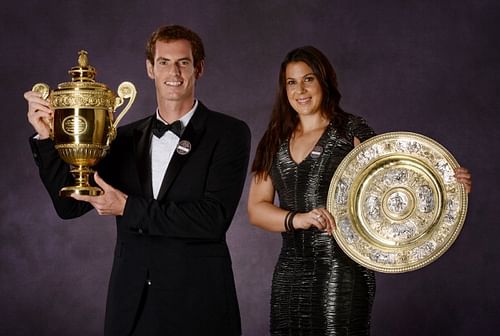
Lessons learnt from Wimbledon 2013

Andy Murray (left), Marion Bartoli
Wimbledon, 2013 was the refresher course we all needed.
Here we were, fed on a steady diet of world domination by a select few, accepting a limited number of patterns and trends as exhaustive, and restricting our focus to a handful of players and issues. Wimbledon this year changed all that.
It made us relook at the fundamentals of why we follow the sport. And in the process, it imparted to us a few key lessons – some fresh ones, and some dredged from the abysses of our memory. So, what did we learn over the course of a captivating fortnight from SW19?
There is more than one formula to achieve success
Coming into the Championships, Marion Bartoli was a freak. She played double-handed on both sides, she had a service action with as much horizontal motion as vertical, she expended too much energy playing shadow-tennis between points, she did not have the necessary champion’s physique.
Yes, she had made it to the Wimbledon final before, but that was just a fluke, it wouldn’t happen again. You could hardly blame the poor girl anyway, with that eccentric, controlling dad-of-a-coach of hers.
But as Bartoli drilled yet another forehand past her hapless opponent on Saturday, all preconceived notions of the ‘right’ way to play were gradually dropping by the wayside.
She remained fiercely focused even as the more ‘conventional’ Lisicki melted under pressure. Here was a tennis player who knew better than most, that what works for one person doesn’t have to work for another.
In an age of tennis academies, defining a uni-dimensional formula for tennis success, Bartoli brought her unique weapons to the contest. In her distinctive style, she hopped, jumped and pumped her way to her maiden Wimbledon title and into the history books.
Perseverance pays
The biggest storyline of the Championships had to be Andy Murray and his maiden Wimbledon title. In the process, he became the first Briton in 77 years to lift the Men’s Singles trophy (how many times did we hear the magic words ‘77’ over the last fortnight?).
Given the home pressure he was constantly under, given that he was facing an in-form World Number 1 in the final, given the weight of history on his back, it was a remarkable effort from the Scotsman. In the end though, perhaps the most surprising thing about Murray’s success was that it didn’t come as a surprise at all.
There was a high degree of justifiable belief this time in Murray’s cause, purely because of the weight of his consistent performances so far.
He had always been on a gradual incline over the years (and still is), adding new facets to his game, working on his fitness, ironing out tactics with Ivan Lendl. His game never suffered any prolonged dips in form, it remained as bull-headed and persistent as the man himself.
Murray’s comfort with his home Grand Slam tournament was evident for quite some time. He made it to the semi-finals at Wimbledon on three consecutive occasions from 2009 to 2011, and went one step further to the final last year.
Murray’s perseverance made his eventual victory seem but a natural culmination of all his efforts over the years. As he kept repeating in post-tournament sound bytes, he had always “tried hard”.